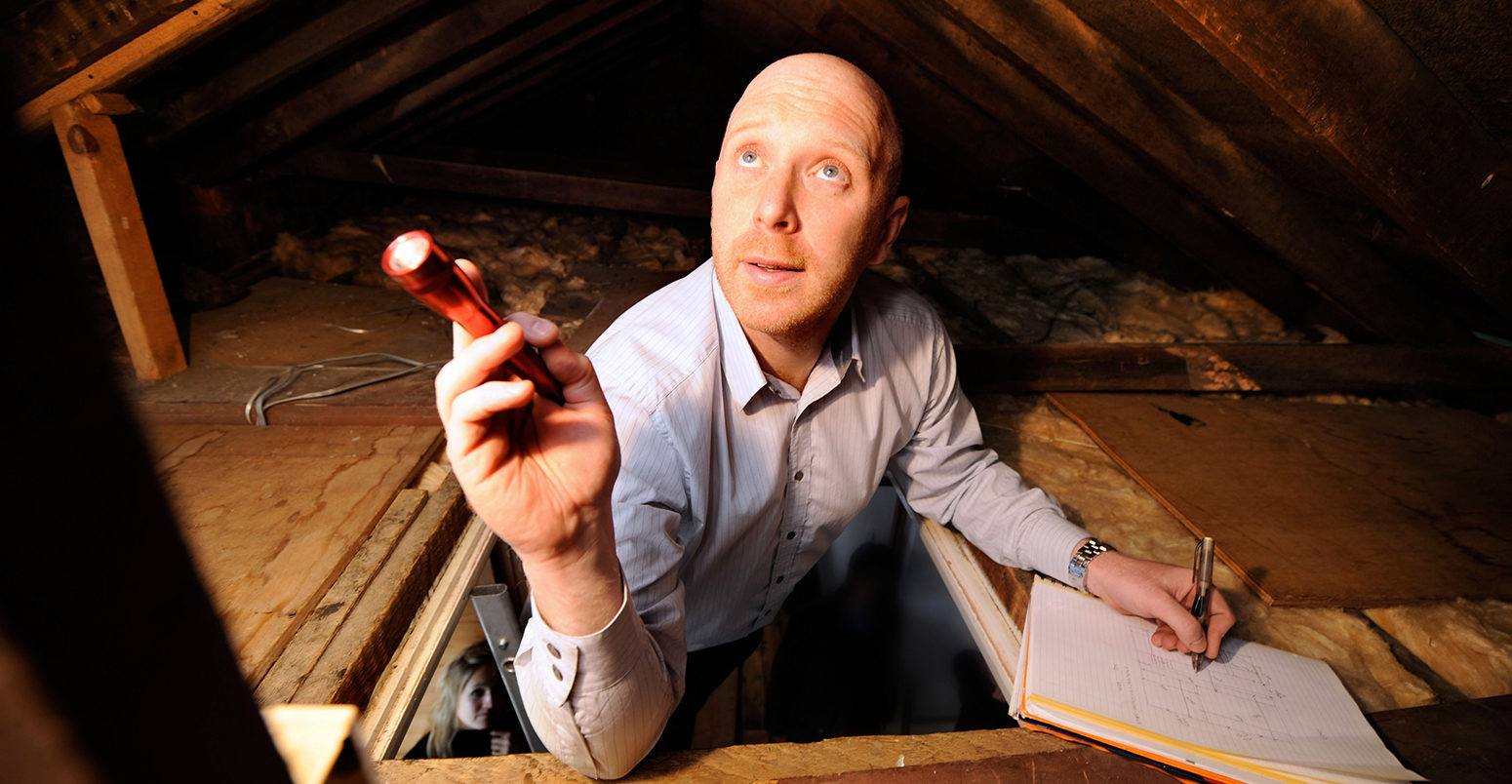
In-depth: How the ‘Clean Growth Strategy’ hopes to deliver UK climate goals
Multiple Authors
10.12.17Multiple Authors
12.10.2017 | 5:40pmToday, the UK government published its long-awaited Clean Growth Strategy, setting out how it hopes to meet the nation’s legally binding climate goals.
The strategy covers the fourth and fifth carbon budgets, spanning 2023-2027 and 2028-2032, by when the UK must cut its greenhouse gas emissions to 57% below 1990 levels.
Launched amid a sea of positive language from government, including the prime minister herself, the quantified elements of the strategy nevertheless leave the UK significantly off track achieving its targets. This means the government is largely relying on hoped-for policies or carbon budget “flexibilities”.
Carbon Brief has a summary of the key points from today’s strategy.
Carbon budget challenge
The UK’s 2008 Climate Change Act sets a framework for legally binding five-year carbon budgets. These are staging posts towards a long-term goal of cutting greenhouse emissions to 80% below 1990 levels by 2050.
It’s important to note that this target was set in the context of a global goal to avoid warming of more than 2C above pre-industrial levels. This is not in line with the more ambitious Paris Agreement limit of “well below” 2C and aiming for 1.5C. (See below for more on the 2050 goal and the three illustrative “pathways” the government uses to show how its 2C-compatible goal could be met.)
The 57% cut for the fifth carbon budget in 2028-2032 was set last June, in line with the advice of the Committee on Climate Change (CCC), the government’s advisory body. This is a significant challenge, requiring emissions cuts across all sectors of the economy. The CCC says the UK is off track towards this target.
This graph shows UK's huge challenge to meet 5th carbon budget. Cuts needed across whole economy.https://t.co/kv9WyxWoG3 pic.twitter.com/Wa9TKA0qKk
— Simon Evans (@DrSimEvans) October 9, 2017
Today’s 165-page Clean Growth Strategy is supposed to plug this gap, setting out new policies to raise UK ambition across the board. It meets a requirement in the act to publish proposals “as soon as reasonably practicable” after each carbon budget is agreed.
The publication has been repeatedly delayed by, among other things, the EU referendum and June’s general election. It was initially to be called a “carbon plan”, like its 2011 predecessor. Then it was an “emissions reduction plan” to be published “towards the end of 2016”. This was later put off until “after the [2017] summer recess” and finally evolved into a “strategy”, rather than a plan.
This series of delays reflects a shifting view within government of how the document should be portrayed, particularly after the ministerial changes that followed the election. The positive framing implied by pairing “clean” and “growth” is a deliberate shift.
In a foreword, prime minister Theresa May writes: “Clean growth is not an option, but a duty we owe to the next generation…[It] also benefits our wider economic prosperity.”
Greg Clark, the secretary of state for business, energy and industrial strategy (BEIS), continues this theme. He writes: “The move to cleaner economic growth is one of the greatest industrial opportunities of our time. This strategy will ensure Britain is ready to seize that opportunity.”
Policy gaps remain
The change from a “plan” to a “strategy” is also deliberate, marking out today’s document as more tentative and less fully formed. This means it contains plenty of aspirations and proposals for future action while being lighter on specific policy details (see below).
As a result, it is perhaps not surprising that the quantified impacts of the strategy add up to a 53% emissions reduction, just two percentage points better than existing policies and still well short of meeting the fifth carbon budget’s 57% target. [Correction 13/10: A previous version of this article said the strategy would cut emissions 51% ; this only reflects existing policies].
Annual emissions during the UK’s first five carbon budgets (millions of tonnes of CO2 equivalent). The annual average emissions cap is shown in black, along with projections under existing policies (dashed blue line) and with the quantified policies of the Clean Growth Strategy (red line). Source: BEIS Clean Growth Strategy. Chart by Carbon Brief using Highcharts.Note that this only includes “initial estimates of a subset of new early stage policies and proposals” set out in the strategy. In other words, not everything was fully-formed enough to be quantified. In a statement to parliament, climate minister Claire Perry says emissions savings from only 30% of the policies in the strategy have been counted.
The strategy also emphasises the uncertainty inherent in projections of policy impacts, economic growth, societal change, technology development and emissions.
The strategy “fails to put us on track to meet legally binding emissions targets”, says a tweeted statement from ClientEarth. The legal NGO adds: “We are considering our legal options.”
Any legal challenge to the strategy would centre on sections 13-14 of the Climate Change Act. Section 13 says the government must prepare “such proposals and policies as the secretary of state considers will enable the carbon budgets…to be met”.
If the unquantified parts of the strategy are insufficient to bridge the gap, the government says it could also rely on flexibilities available under the Climate Change Act. These include carrying forward expected over-achievement in earlier budget periods, borrowing against over-achievement in future budgets, or buying international emissions offsets to make up the difference.
This is worth a *close* read – the smallprint on why the UK govt expects to miss the 4th + 5th carbon budgets #WiggleRoom pic.twitter.com/AlP11zd1pa
— Leo Hickman (@LeoHickman) October 12, 2017
The CCC has previously argued against using these flexibilities, saying explicitly that budgets should be met without international offsets. In a 2014 letter, it says carry-forward should only be used where over-achievement is the result of policy being ahead of schedule.
In a statement welcoming today’s publication, CCC chair Lord Deben says:
We note that the Clean Growth Strategy suggests that ‘flexibilities’ in the Climate Change Act could be used to meet the carbon budgets in place of domestic action. This should not be the plan. The clear intention of the UK’s fourth and fifth carbon budgets is that they are delivered through domestic action to keep the UK on the lowest cost path to the 2050 target to reduce emissions by at least 80% compared to 1990 levels. That should be the goal, without the use of accounting flexibilities or reliance on international carbon credits.
The CCC will issue a formal assessment of today’s strategy early in 2018.
Monitoring progress
Separately, the government says it will publish yearly scorecards on the strategy, as part of its responses to the CCC’s annual reporting. It will also revive a cross-Whitehall “Clean Growth Inter-Ministerial Group”, due to meet “regularly” to monitor progress.
The government has set itself a new self-reported metric by which it wants to measure its progress. It has developed something called the Emissions Intensity Ratio (EIR) which it will use to “measure our clean growth performance”. It plans to publish it each year. This is how it explains the EIR:
“It measures the amount of greenhouse gases (tonnes of carbon dioxide equivalent) produced for each unit of Gross Domestic Product (GDP) created. Currently the EIR is 270 tonnes/£ million and it was 720 tonnes/£ million in 1990. By 2032, we expect the EIR will need to be nearly as low as 100 tonnes/£ million to meet our ambitions.”
It adds that to reach its 2032 targets the EIR will need to fall by an average of five per cent per year, which is an acceleration compared to the 4% annual fall since 1990.
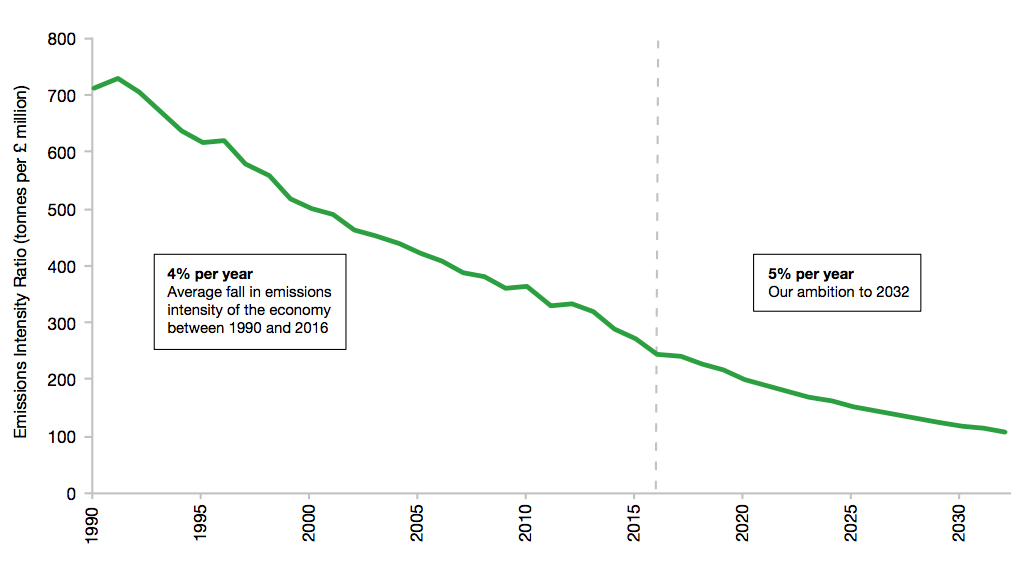
Historic and projected Emissions Intensity Ratio (EIR) Source: BEIS Clean Growth Strategy.
Brexit accounting
Note that UK carbon budgets are based on the “net carbon account”. This means that actual emissions from power and industry (sectors covered by the EU Emissions Trading System, EU ETS) are not counted when measuring progress. Instead, the UK’s share of the ETS cap is used.
“Strictly speaking, the only parts of the plan that will be relevant to meeting the carbon budget are heat, transport and agriculture,” says Damien Morris, director of Futureproof Consulting.
See this Carbon Brief article for a more detailed discussion of carbon budget accounting. Importantly, if the UK leaves the EU ETS when it leaves the EU, these accounting rules – and the UK’s carbon target – would have to be changed.
The CCC recommended a 61% cut in territorial emissions for the fifth carbon budget. It is unclear if this would be harder or easier to meet than the 57% goal, based on the UK’s share of the ETS cap.
The strategy says: “The Government is considering the UK’s future participation in the EU ETS after our exit from the EU and we remain firmly committed to carbon pricing as an emissions reduction tool”.
Home efficiency
Homes account for around 13% of the UK’s emissions. The government argues its new policies will substantially reduce emissions from housing over the next decades, as the chart below shows.
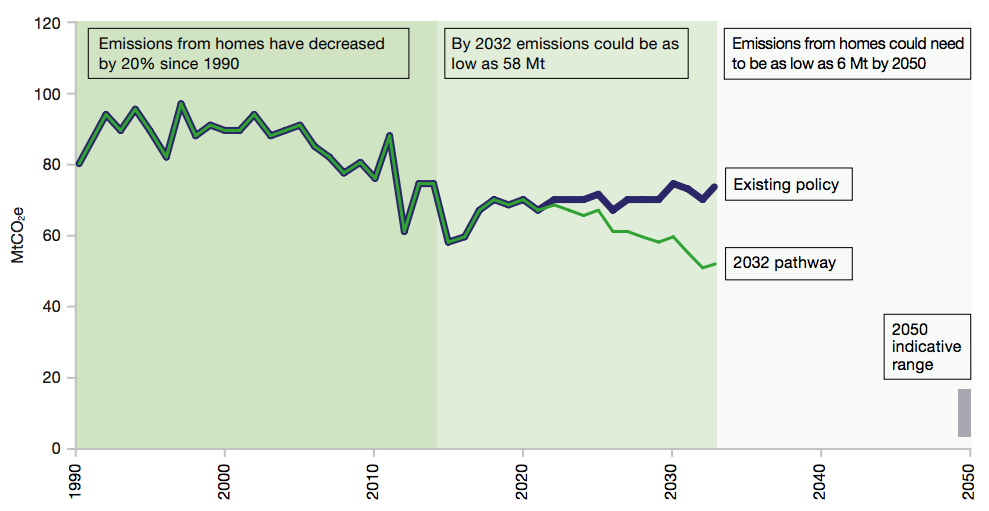
Actual and projected emissions in homes, taking into account the clean growth pathway, 1990-2050. Source: BEIS Clean Growth Strategy.
The new strategy promises around £3.6bn to upgrade the energy efficiency of a million homes, with the Energy Company Obligation (ECO) extended to 2028 at its current level.
11/n no mention of zero C homes. ECO continued but looks more like being dragged. Need more clarity of ECO scope. #CleanGrowthStrategy
— chaitanyakumar (@chaitanyakumar) October 12, 2017
Across the housing sector, the aspiration is for “as many homes as possible” to reach Energy Performance Certificate (EPC) Band C by 2035. This would mean 19m homes being upgraded. A recent report from consultancy Frontier Economics advised the government to set a requirement for all homes to reach a minimum EPC Band C by 2035.
The strategy aims for all fuel poor homes and as many privately rented ones as possible to reach this standard by 2030. (Private rentals already have to meet at least Band E by April next year). New EPC standards for social housing will be considered.
There is little firm detail yet on how these aspirations will be met. The government has today launched a call for evidence on how to overcome barriers to investment in energy efficiency.
There is no mention of replacing the zero-carbon homes standard scrapped in 2015. The Frontier Economics report argued this standard should be reintroduced, to avoid new homes needing costly retrofits in future.
However, the government will consult on strengthening building regulations for new and existing homes – including “future-proofing new homes for low carbon heating systems”.
The strategy also reiterates the government’s previous target for energy suppliers to offer every home a smart meter by 2020.
The strategy says that government policy has cut energy bills through efficiency by more than the cost of supporting low-carbon generation, as the chart below shows. This agrees with analysis from the CCC.
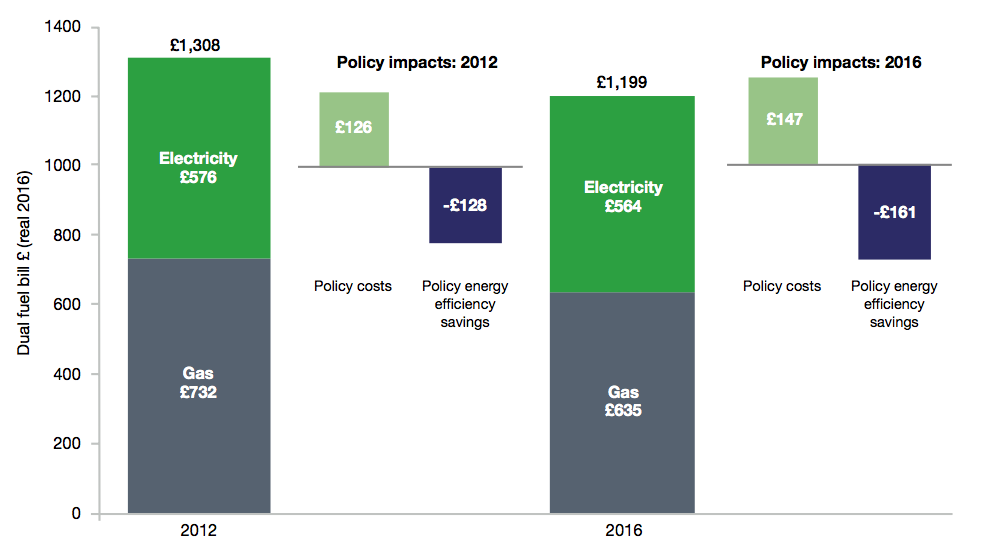
Average annual household dual fuel bill, 2012 and 2016. Source: BEIS Clean Growth Strategy.
Low carbon heat
The strategy acknowledges that reducing demand through improved energy efficiency will not by itself suffice to meet the UK’s 2050 target. Heat for homes, businesses and industry accounts for nearly half of all energy use in the UK – and a third of carbon emissions.
The strategy says the groundwork needs laying in this parliament, so decisions can be taken in the early 2020s on the long-term future of heat. It will assess a range of options for decarbonising heat, including electric heat pumps, using hydrogen or biogas in the gas grid and heat networks.
Initial findings will be published later this year, with a full report following by summer 2018. It’s worth noting the CCC has said UK heating must be virtually zero-carbon by 2050.
Meanwhile, the Renewable Heat Incentive is already being reformed to focus more on long-term decarbonisation via technologies such as heat pumps and biogas. It will spend £4.5bn to support innovative low-carbon heat technologies in homes and businesses between 2016 and 2021.
A new £10m innovation programmes will also aim to develop new heating technologies in homes and commercial buildings. A further policy will aim to phase out installations of high-carbon fossil fuel heating in homes not yet connected to the gas grid.
Electricity sector
The power sector is responsible for 21% of UK emissions – and for the lion’s share of progress in cutting them since 1990, with a shift away from coal being the main driver. Now that coal is close to disappearing from the UK electricity mix, this emissions dividend has mostly been used up.
Nevertheless, today’s strategy reaffirms the pledge to phase out unabated coal generation by 2025, cementing this shift and ensuring there will be no backsliding. It says it will publish a response to its consultation on how to end coal use “shortly”.
The end of coal generation will be part of plans to drive substantial further cuts in power sector emissions, as the chart below shows.
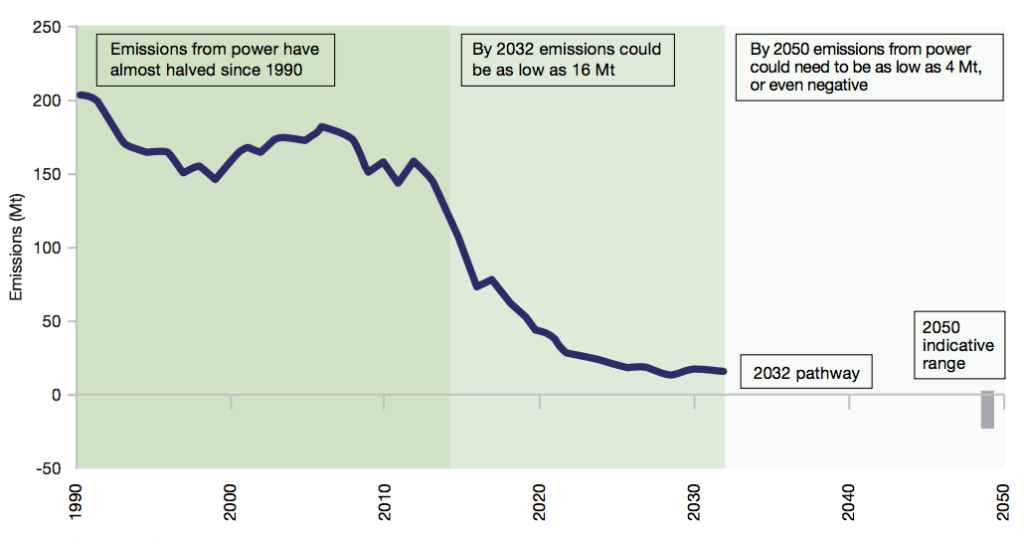
Actual and projected emissions in the electricity sector, taking into account the clean growth pathway, 1990-2050. Source: BEIS Clean Growth Strategy.
The government hopes low-carbon sources of power will account for more than 80% of supplies by 2030, up from around 50% today. Beyond the Hinkley C nuclear plant, the government says further new reactors would have to be cheaper. It commits R&D funds to this cause (see below).
Offshore wind will compete for up to £557m in low-carbon support, confirmed yesterday but first announced in 2016, with onshore wind on Scottish islands also allowed to compete, subject to state aid approval from the European Commission. The next auction will be held in spring 2019.
Offshore wind was cheaper than new gas at the last auction, so the £557m could buy much more capacity than expected. The strategy repeats a 10 gigawatt (GW) target for new offshore wind in the 2020s and says it will consider going even further “if this is cost-effective and deliverable”. The government will provide an update on its approach to small-scale renewables “later this year”.
The government will set out details of carbon pricing beyond 2020/21 at the budget, on 22 November. It says it “remain[s] firmly committed” to the idea and will target a total price for the power sector. This will replace the current system, where utilities pay a floating amount per tonne of CO2, made up of the ETS price plus the UK’s carbon price floor.
The budget will also set out details of the replacement for the Levy Control Framework (LCF), which has been used to cap the cost of low-carbon subsidies.
On energy bills, the government will this autumn publish the independent cost of energy review, having already today published draft legislation towards capping standard variable tariffs. It also plans to continue its flexibility plans, including adding 14GW of power links to other countries.
Business and industry
The chart below shows past and future projections of emissions across business and industry, with and without the new policies set out in the strategy. The sectors account for 25% of UK emissions.
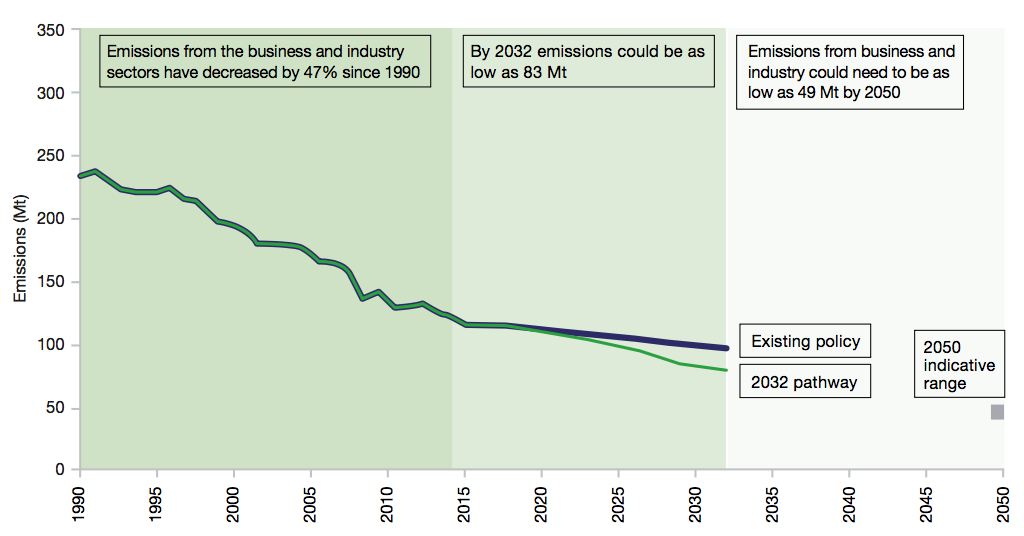
Actual and projected emissions in business and industry, taking into account the clean growth pathway, 1990-2050. Source: BEIS Clean Growth Strategy.
Up to £6bn could be saved in business and industry by 2030 through investment in energy efficiency, the strategy says.
The government proposes a new target for these sectors to improve their energy efficiency by “at least” 20% by 2030. A final decision on the exact level of this goal will be made in 2018, taking into account the recommendations of Prof Dieter Helm’s forthcoming “cost of energy” review.
To help meet this goal, a new “Industrial Energy Efficiency” scheme will help large companies cut their bills. Government will consult on raising minimum energy efficiency standards for rented commercial buildings.
A set of joint industry-government decarbonisation and energy efficiency plans will also be developed for seven of the most energy intensive industrial sectors, including cement and chemicals.
These will need to go further than energy efficiency, the strategy says. There will need to be a switch from fossil fuel use to low-carbon fuels, such as sustainable biomass, in the period up to 2030. Post-2030, this switch will need to accelerate, coupled with the use of new technologies, such as carbon capture and storage (CCS).
Using potentially low-carbon fuels, such as hydrogen, is currently prohibitively expensive, the strategy notes. It promises up to £20m to demonstrate the viability of switching to low-carbon fuels in industry. A new £18m industrial heat recovery programme is also in the works.
The overall framework to support this decarbonisation of heavy industry will be developed over the course of the current parliament. A “new and streamlined” business energy and carbon reporting framework will also be consulted on then introduced by 2019.
Carbon capture and storage
The strategy sets out plans to invest up to £100m in carbon capture usage and storage (CCUS) and industrial innovation.
This sum includes up to £20m for a carbon capture and utilisation demonstration for new technologies and an extra £10m for the UK’s £60m international CCS programme, which has been running since 2012.
While a significant sum, it’s worth noting that the £100m is just a tenth of the £1bn CCS scheme promised by the previous Conservative government’s manifesto in 2015. Since the scheme was axed in November 2015, the CCC has persistently called for the government to implement a new CCS strategy. The committee considers CCS “vital” to meeting the longer-term Paris goals.
The strategy highlights the importance of “international collaboration” in the development of CCUS, (most notably with Norway, since the strategy also says it will look for storage opportunities elsewhere than the UK via international shipping).
It also flags future support for application of CCUS in low-carbon hydrogen production, bio-energy with CCS (BECCS) and transport and storage of CO2, with further details coming in 2018.
The government plans to set further details of its CCUS “deployment pathway” in 2018, with the aim of deploying CCUS at scale during the 2030s (though this is “subject to costs coming down sufficiently”).
A new ministerial-led CCUS Council with industry, which will review progress on carbon capture, is also in the works, while the government is planning to host an international CCUS event in 2018.
Transport emissions
The transport sector accounts for 24% of UK emissions, with almost zero progress since 1990.
Last month, the government announced it will end the sale of all new conventional petrol and diesel cars and vans by 2040. This was a recognition, it said, that the transport sector needs to rapidly decarbonise, if it is to meet its share of the UK’s climate goals.
Today’s strategy reiterates: “To meet our 2050 target, almost every car and van will need to be zero emission by 2050…By 2040, we want cycling and walking to be the natural choices for shorter journeys, or as part of a longer journey.”
It adds that “we are spending £1bn to drive the uptake of ULEVs [ultra low emission vehicles]” and that the forthcoming Automated and Electric Vehicles Bill, announced in the latest Queen’s speech, will help to boost the rollout of EV charge points and hydrogen refuelling infrastructure.
It says that “one possible pathway” to meeting the fifth carbon budget could involve emissions from transport “falling by almost 30%” compared to today. It says an important contribution would be delivered on roads, where “at least 30% of new car sales are expected to be ULEVs by 2030 and possibly as many as 70%”.
It’s worth noting, though, that the CCC’s sectoral scenarios for the fifth carbon budget published in 2015 show that “the combination of plug-in hybrids and battery electric vehicles reach [around 60% in 2030] of new car and van sales”.
Here's why transport is one of the toughest nuts to crack. Look at where it needs to be by 2050… pic.twitter.com/afagrSnogZ
— Leo Hickman (@LeoHickman) October 12, 2017
However, today’s strategy largely summarises previous policy and R&D commitments and noticeably lacks specifics on new policies, simply saying: “The Government will set out further detail on a long term strategy for the UK’s transition to zero road vehicle emissions by March 2018.”
On aviation and shipping, it says:
“We will set out our strategic approach to the aviation sector in a series of consultations over the next 18 months, including a paper on how to support growth while tackling the environmental impacts of aviation. This will culminate in the publication of a new Aviation Strategy for the UK by the end of 2018…On domestic shipping, the Government will continue to work with industry to develop improved fuel efficiency technologies, including new propulsion systems, hull design and aerodynamic structures.”
(See the 2050 Pathways section below for more on the government’s long-term view on how it sees aviation emissions sitting within the 2C target.)
Farming and land use
The strategy includes minimal new policy for managing natural resources, which account for around 15% of the UK’s emissions.
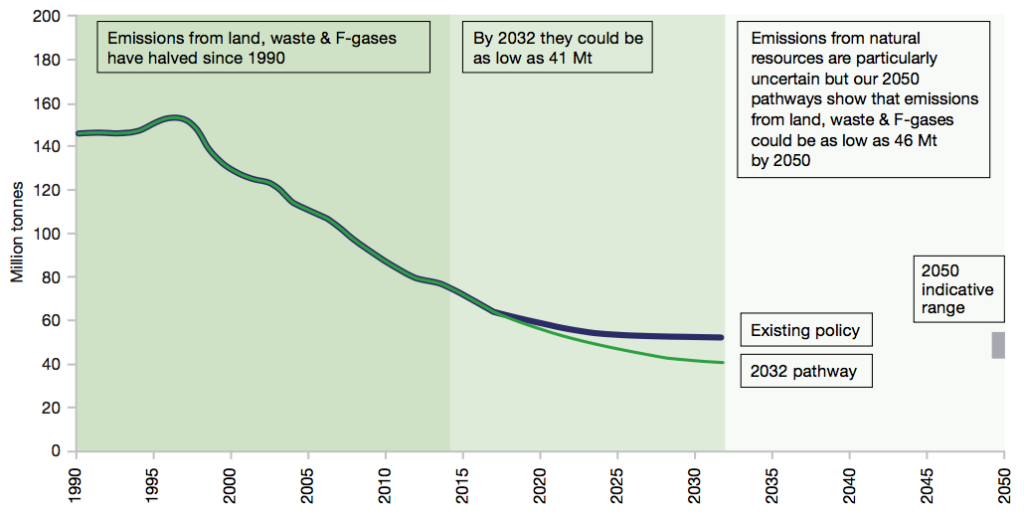
Actual and projected emissions in natural resources, taking into account the clean growth pathway, 1990-2050. Source: BEIS Clean Growth Strategy.
However, it emphasises the opportunities which could come from Brexit, including leaving the Common Agricultural Policy (CAP). A “new system of future agricultural support” could focus on delivering better environmental outcomes – including addressing climate change more directly.
Earlier this year, the government allocated funding for a new network of forests in England. The government has a target to reach 12% of woodland cover in England by 2060, up from 10% today.
The government expects to invest £99m overall by 2021 on innovation in natural resources, while a further £10m capital grant scheme will go to peat restoration. It will also publish a Resources and Waste Strategy in 2018.
R&D funding
The strategy includes a number of pledges to increase research-and-development (R&D) spending to further drive decarbonisation. It says:
“This strategy sets out for the first time how over £2.5 billion will be invested by the Government to support low carbon innovation from 2015 to 2021. More broadly, the National Productivity Investment Fund will provide an additional £4.7 billion, with an extra £2 billion a year by 2020-21, representing the largest increase in public spending on UK science, research and innovation since 1979.”
Specifically, it says the government “expects to invest around £900m of public funds between 2015 and 2021 in research and innovation in the power sector”. Within this, it says that it “expects” to invest “around £265m” in R&D to help “reduce the cost of electricity storage, advance innovative demand response technologies and develop new ways of balancing the grid, for example using EV”. This will be done in partnership with the Research Councils and Innovate UK.
This same partnership will also oversee an investment of “around £460m” in the power nuclear sector, which will include “future nuclear fuels, new nuclear manufacturing techniques, recycling and reprocessing, and advanced reactor design”.
With regard to renewables, the partnership will invest “around £177m” in areas that include “innovation in offshore wind turbine blade technology and foundation…floating offshore wind platforms and advanced solar PV technologies”.
Other R&D commitments include:
- Invest around £162m of public funds in research and innovation in Energy, Resource and Process efficiency, including up to £20m to encourage switching to lower carbon fuels.
- Support innovative energy technologies and processes with £14m of further investment through the Energy Entrepreneurs Fund.
2050 pathways
Within the technical annex of the strategy, the government explains why it has chosen three illustrative “pathways” to show how it could meet the “80% by 2050” target:
These three have all been deliberately selected to illustrate a wide range of possible pathways; for example, from 100 per cent battery electric cars to 100 per cent hydrogen fuel cell cars. However, different pathways within this range, and beyond this range, are also possible. All three 2050 pathways are consistent with the sector emissions levels in the 2032 pathway presented in this Strategy. They do not represent the most likely or preferred pathways to meeting the 2050 target, but show that the 2032 pathway would leave open a wide range of options for 2050.
The three pathways it uses are: 1) Electricity; 2) Hydrogen; 3) Emissions removal.
Put simply, the “electricity” pathway uses EVs and heat pumps, with power demand rising 80%; “hydrogen” sees continued gas use for heat; and “emissions removal pathway” uses negative power sector emissions from BECCS to balance residual emissions elsewhere.
It provides the following table to show sectoral “characteristics” within each of the three pathways.
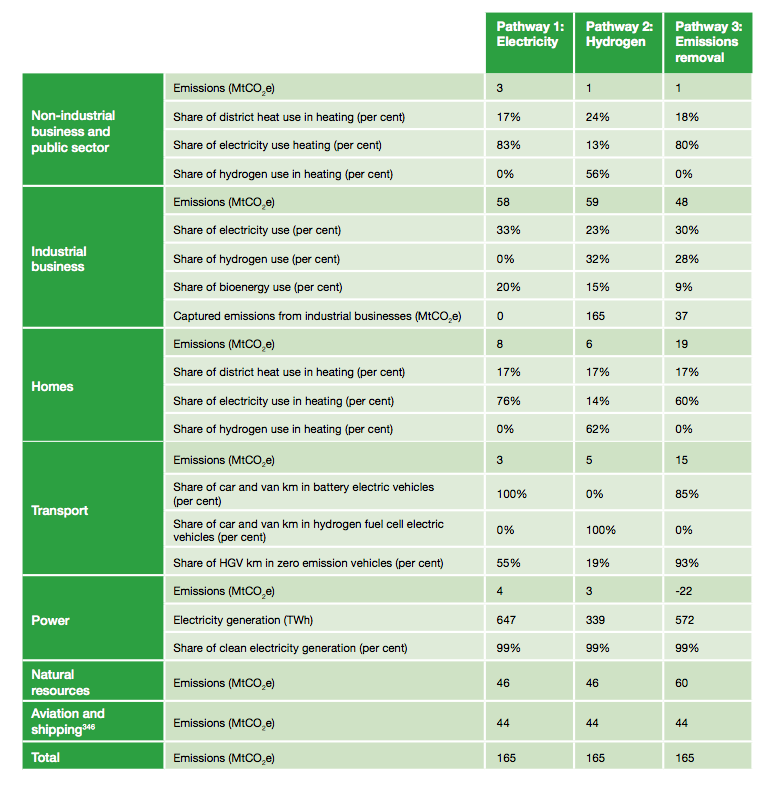
Characteristics of the 2050 pathways in 2050 Source: BEIS Clean Growth Strategy.
It’s noteworthy that in its emissions removal pathway it shows that the power sector would actually be removing 22MtCO2e in 2050, thereby allowing more headroom for transport, buildings and agriculture to decarbonise more slowly. It also assume no CCS in pathway 1 (electricity).
It’s also eye-catching that all three pathways assume the same emissions from the aviation and shipping sectors. The number given seems to be something of a placeholder, though. This is because: “The Government has not reached a final view on the appropriate level of international aviation and shipping emissions in 2050.”
It adds, by way of further explanation for the figure chosen in the table:
“Our analysis shows that it is possible to meet the 2050 target under the Climate Change Act domestically if aviation emissions are 44MtCO2.” (Given this part of the strategy is discussing both aviation and shipping, the absence of the word “shipping” here is noticeable.)
However, as Carbon Brief reported last year, the CCC has said that UK aviation emissions should be limited to no more than 2005 levels, if the UK is to meet its 2050 carbon targets as cheaply as possible. This would mean a cap of 37.5MtCO2e for UK-based air travel.
It is important to stress that the strategy is only “2C compatible”. It does not seek to set out policies which would guide the UK towards meeting the 1.5C goal of the Paris Agreement.
The CCC has said that UK GHG emission reductions would need to be “at least 90% below 1990 levels by 2050” if it were to meet its fair share of the 1.5C goal.
However, the CCC said in early 2016 that it did not currently advise that the UK’s fifth carbon budget should be tightened in light of the Paris Agreement’s aspirational 1.5C target. Later that year, though, it did say that the UK would need to rely on negative emissions in order to comply with the 1.5C goal and that the UK would need to – although not yet – set a “net-zero emissions” target because the current “80% by 2050” target would not be adequate.
Today’s strategy agrees with the CCC on both these points. It says:
“Our obligations under the Climate Change Act only take us to 2050, and…now is not the right time to set a post-2050 net zero goal. We need to understand more about the global path to net zero emissions, and believe that our focus should be on meeting our existing targets. However, the Government believes the UK will need to legislate for a net zero emissions target at an appropriate point in the future, to provide legal certainty on where the UK is heading.”
Negative emissions
The strategy includes a short section devoted to greenhouse gas removal (GGR) technologies, also known as negative emissions. (See Carbon Brief series of articles on the topic.)
The government admits that they “are likely to have an important role to play in offsetting difficult-to-cut emissions, by removing greenhouse gases from the air”.
This is because, as the UK approaches 2050, its remaining emissions “will likely be in the sectors where it is the most difficult to cut them – in industry, agriculture, aviation and shipping”.
It says it wants the “UK’s entrepreneurs, universities and engineering industries to be well placed to exploit the advantages of global demand for these new technologies”.
It says it will now “conduct a study” on how GGR can be incentivised, adding:
“We will also consider how legal, financial and regulatory frameworks could support the rollout of GGR technologies at scale. We will develop our strategic approach for GGR technologies, including consideration of whether to reprioritise existing innovation spend, in light of these pieces of work.”
The government says it intends to “set out further detail in 2018” how it will use the BEIS Energy Innovation Programme to “develop our understanding of the role of GGR technologies”. Earlier this year, the government launched a new £8.6m research programme looking at negative emissions, as reported by Carbon Brief at the time.
BEIS wants *your* views on its Clean Growth Strategy – and welcomes you to celebrate its new annual Climate Week pic.twitter.com/zFjDQbpTLN
— Leo Hickman (@LeoHickman) October 12, 2017
-
In-depth: How the ‘Clean Growth Strategy’ hopes to deliver UK climate goals

